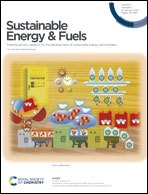Interfacial synergy of Pt cocatalyst and oxygen defective Bi2MoO6 for boosting the photocatalytic redox reaction†
Abstract
Photocatalytic redox reactions using dioxygen as the source of oxygen atoms provide an ideal route for transforming organic compounds into high-value chemicals under mild conditions. However, due to a lack of active sites for oxidation and reduction reactions, photocatalytic redox reactions are sluggish, severely impeding their large-scale potential application. To address this issue, we constructed a highly active Pt/Bi2MoO6-VO photocatalyst for the photocatalytic selective oxidation of benzylic alcohols under visible light by creating surface oxygen vacancies (VOs) and Pt nanoparticles as dual catalytic sites. The photocatalyst with dual active sites exhibited approximately 7- and 41-times the photoactivity of the Bi2MoO6-VO (with VOs) and Bi2MoO6 (without VOs) catalysts, respectively, achieving 4.1 mmol g−1 h−1. The computational and experimental results show that the dual-active-site synergy can effectively promote the separation of photogenerated carriers and activate benzylic alcohols and dioxygen. This study demonstrates that interface engineering by creating dual-active sites can effectively enhance the activity of Bi2MoO6 based photocatalysts, which provides a useful strategy for rationally designing high-active photocatalysts for photocatalytic redox reactions.



 Please wait while we load your content...
Please wait while we load your content...